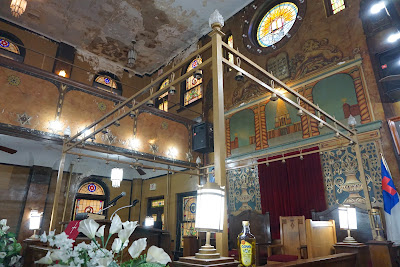 |
| The Bronx, NY. Green Pastures Baptist Church (former Chevra Linas Hazedek), Paul Lubroth, architect. 1928-32. Photo: Samuel D. Gruber 2017. |
 | |||
| The Bronx, NY. Green Pastures Baptist Church (former Chevra Linas Hazedek), Paul Lubroth, architect. 1928-32. Photo: Samuel D. Gruber 2017. |
 |
| The Bronx, NY. Green Pastures Baptist Church (former Chevra Linas Hazedek), Paul Lubroth, architect. 1928-32. Photo: Samuel D. Gruber 2017. |
by Samuel D. Gruber
Last year I began a more focused project to locate and document traces of synagogue wall painting in the United States. This grows directly with my involvement over several years with the rescues and conservation of the large mural in Burlington, Vermont. In May I had the chance to pull some of the new research together in a presentation for the Friedman Society at the Jewish Museum in New York. Of all the examples of wall painting I showed, I think the most astonishing were paintings of the Green Pastures Baptist Church on Ward Avenue in the Soundview neighborhood of the Bronx, New York. The church was formerly home of the Jewish congregation Chevra Linas Hazedek, built between 1928-1932, and apparently designed by Polish-born Bronx architect Paul Lubroth. The New York audience was especially astounded in part because these decorations existed only a short subway ride from Manhattan, but are mostly unknown.
 |
| The Bronx, NY. Green Pastures Baptist Church (former Chevra Linas Hazedek), Paul Lubroth, architect. 1928-32. Photo: Samuel D. Gruber 2017. |
Rev. Roger Hambrick gave me a tour and something of the history of the church, where his father had previously presided, and where the younger Rev. Hambrick has created at the small congregation a nationally recognized choir. In addition to the wall paintings and stained glass windows the church preserves the dedicatory and memorial plaques from the Jewish congregation. Taken together these form an exceptional collection, but the striking and unusual mural of the Temple over the Ark deserves special attention.
In 2009 Ian Dull had described the interior in the Conservancy's Sacred Sites Program's publication Common Bond this way:
[the interior is] covered from floor to ceiling in rich scagliola (highly polished and colored plaster imitating marble or granite, Art Deco decorative painting, and theatrical, Jazz Age lighting. From the window border stencils and a handsome Decalogue (the Ten Commandments) with fierce, flanking lions painted above the altar [sic]; to the marquee-like rows of bulbs marching around the face of the balcony and circling a roundel window; and on to the fluted light fixtures, featuring both stylized tulips, magen david (shield of David or star of David) motifs – some of which dot the surfaces of the sanctuary unobtrusively, and others which hang on chandeliers in all of their Moderne glory – the interior of Green Pastures is a sight to behold. Opalescent stained glass windows throughout the synagogue are intact from original design, with symbols depicting Jewish holiday s and events from the Torah [actually, Twelve Tribes of Israel and the zodiac signs for the months of the Hebrew calendar].Surprisingly, Dull did not mention the prominent depiction of the Jerusalem Temple in the form of a stepped pyramid that takes images of ancient tombs and temples - probably the most unusual and interesting feature of the decoration. It seems the artist took these ideas and filtered them through a lens that could have been held by Cecil B. DeMille filming a biblical epic for a Hollywood Studio (such as his King of Kings released in 1927). The painted synagogue image combines Near Eastern forms with Art Deco design, a ziggurat idea with Assyrian-inspired decoration that many Art Deco Manhattan architects were also trying (think Ghostbusters!).
One views the Temple through a painted arcade supported by painted twisted columns. These seem to refer to the medieval tradition that believed (without historical basis) that the Hellenistic twisted columns used in Saint Peter's Church in Rome to mark the grave of Peter were, in fact, originally from Solomon's Temple.
 |
| The Bronx, NY. Green Pastures Baptist Church (former Chevra Linas Hazedek), Paul Lubroth, architect. 1928-32. Photo: Samuel D. Gruber 2017. |
 |
| The Bronx, NY. Green Pastures Baptist Church (former Chevra Linas Hazedek), Paul Lubroth, architect. 1928-32s. Photo: Samuel D. Gruber 2017. |
 |
| The Bronx, NY. Green Pastures Baptist Church (former Chevra Linas Hazedek), Paul Lubroth, architect. 1928-32. Photo: Samuel D. Gruber 2017. |
And it is not just on the walls that there is this synergy. Rev. Hambrick's choir regularly perform with Jewish singer Neshama Carlebach (you can see them in the youtube video from a performance at the Jewish Heritage Museum in New York), and together they released the CD Higher and Higher in 2009.
Unfortunately, the church was badly damaged by Hurricane Sandy in 2012, and even more so when the damaged roof later leaked excessively into the sanctuary. Fortunately, despite much damage to the ceiling, benches, and wooden floors, the wall paintings and windows were mostly unaffected. Money was raised to fix the roof with the help of evangelical church in Texas, but much work is still needed to repair, conserve, and restore the sanctuary from both both gradual deterioration, and the sudden damage caused by the roof failure.
 |
| The Bronx, NY. Green Pastures Baptist Church (former Chevra Linas Hazedek), Paul Lubroth, architect. 1928-32. Photo: Samuel D. Gruber 2017. |
 |
| The Bronx, NY. Green Pastures Baptist Church (former Chevra Linas Hazedek), Paul Lubroth, architect. 1928-32. Photo: Samuel D. Gruber 2017. |
 |
| The Bronx, NY. Green Pastures Baptist Church (former Chevra Linas Hazedek), Paul Lubroth, architect. 1928-32. Photo: Samuel D. Gruber 2017. |



1 comment:
Thank you for this! My mother knew this synagogue as the Ward Avenue Synagogue and I have vague memories of going there with my grandfather as a very small child.
Post a Comment